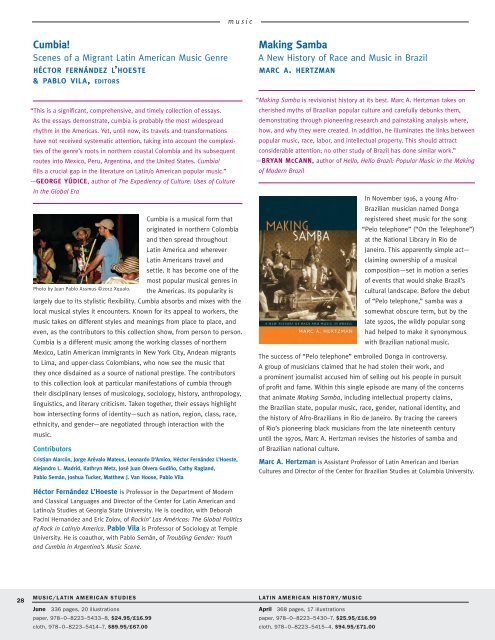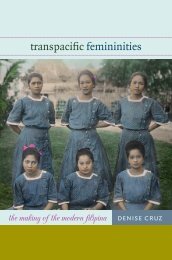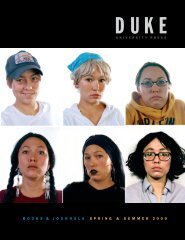Spring 2013 Catalog - Duke University Press
Spring 2013 Catalog - Duke University Press
Spring 2013 Catalog - Duke University Press
Create successful ePaper yourself
Turn your PDF publications into a flip-book with our unique Google optimized e-Paper software.
28<br />
Cumbia!<br />
Scenes of a Migrant Latin American Music Genre<br />
héctor fernández l’hoeste<br />
& pablo vila, editors<br />
“This is a significant, comprehensive, and timely collection of essays.<br />
As the essays demonstrate, cumbia is probably the most widespread<br />
rhythm in the Americas. Yet, until now, its travels and transformations<br />
have not received systematic attention, taking into account the complexities<br />
of the genre’s roots in northern coastal Colombia and its subsequent<br />
routes into Mexico, Peru, Argentina, and the United States. Cumbia!<br />
fills a crucial gap in the literature on Latin/o American popular music.”<br />
—GEORGE YÚDICE, author of The Expediency of Culture: Uses of Culture<br />
in the Global Era<br />
Cumbia is a musical form that<br />
originated in northern Colombia<br />
and then spread throughout<br />
Latin America and wherever<br />
Latin Americans travel and<br />
settle. It has become one of the<br />
most popular musical genres in<br />
Photo by Juan Pablo Assmus ©2012 Xqualo.<br />
the Americas. Its popularity is<br />
largely due to its stylistic flexibility. Cumbia absorbs and mixes with the<br />
local musical styles it encounters. Known for its appeal to workers, the<br />
music takes on different styles and meanings from place to place, and<br />
even, as the contributors to this collection show, from person to person.<br />
Cumbia is a different music among the working classes of northern<br />
Mexico, Latin American immigrants in New York City, Andean migrants<br />
to Lima, and upper-class Colombians, who now see the music that<br />
they once disdained as a source of national prestige. The contributors<br />
to this collection look at particular manifestations of cumbia through<br />
their disciplinary lenses of musicology, sociology, history, anthropology,<br />
linguistics, and literary criticism. Taken together, their essays highlight<br />
how intersecting forms of identity—such as nation, region, class, race,<br />
ethnicity, and gender—are negotiated through interaction with the<br />
music.<br />
Contributors<br />
Cristian Alarcón, Jorge Arévalo Mateus, Leonardo D’Amico, Héctor Fernández L’Hoeste,<br />
Alejandro L. Madrid, Kathryn Metz, José Juan Olvera Gudiño, Cathy Ragland,<br />
Pablo Semán, Joshua Tucker, Matthew J. Van Hoose, Pablo Vila<br />
Héctor Fernández L’Hoeste is Professor in the Department of Modern<br />
and Classical Languages and Director of the Center for Latin American and<br />
Latino/a Studies at Georgia State <strong>University</strong>. He is coeditor, with Deborah<br />
Pacini Hernandez and Eric Zolov, of Rockin’ Las Américas: The Global Politics<br />
of Rock in Latin/o America. Pablo Vila is Professor of Sociology at Temple<br />
<strong>University</strong>. He is coauthor, with Pablo Semán, of Troubling Gender: Youth<br />
and Cumbia in Argentina’s Music Scene.<br />
MUSIC/LATIN AMERICAN STUDIES<br />
June 336 pages, 20 illustrations<br />
paper, 978–0–8223–5433–8, $24.95/£16.99<br />
cloth, 978–0–8223–5414–7, $89.95/£67.00<br />
music<br />
Making Samba<br />
A New History of Race and Music in Brazil<br />
marc a. hertzman<br />
“Making Samba is revisionist history at its best. Marc A. Hertzman takes on<br />
cherished myths of Brazilian popular culture and carefully debunks them,<br />
demonstrating through pioneering research and painstaking analysis where,<br />
how, and why they were created. In addition, he illuminates the links between<br />
popular music, race, labor, and intellectual property. This should attract<br />
considerable attention; no other study of Brazil has done similar work.”<br />
—BRYAN MCCANN, author of Hello, Hello Brazil: Popular Music in the Making<br />
of Modern Brazil<br />
In November 1916, a young Afro-<br />
Brazilian musician named Donga<br />
registered sheet music for the song<br />
“Pelo telephone” (“On the Telephone”)<br />
at the National Library in Rio de<br />
Janeiro. This apparently simple act—<br />
claiming ownership of a musical<br />
composition—set in motion a series<br />
of events that would shake Brazil’s<br />
cultural landscape. Before the debut<br />
of “Pelo telephone,” samba was a<br />
somewhat obscure term, but by the<br />
late 1920s, the wildly popular song<br />
had helped to make it synonymous<br />
with Brazilian national music.<br />
The success of “Pelo telephone” embroiled Donga in controversy.<br />
A group of musicians claimed that he had stolen their work, and<br />
a prominent journalist accused him of selling out his people in pursuit<br />
of profit and fame. Within this single episode are many of the concerns<br />
that animate Making Samba, including intellectual property claims,<br />
the Brazilian state, popular music, race, gender, national identity, and<br />
the history of Afro-Brazilians in Rio de Janeiro. By tracing the careers<br />
of Rio’s pioneering black musicians from the late nineteenth century<br />
until the 1970s, Marc A. Hertzman revises the histories of samba and<br />
of Brazilian national culture.<br />
Marc A. Hertzman is Assistant Professor of Latin American and Iberian<br />
Cultures and Director of the Center for Brazilian Studies at Columbia <strong>University</strong>.<br />
LATIN AMERICAN HISTORY/MUSIC<br />
April 368 pages, 17 illustrations<br />
paper, 978–0–8223–5430–7, $25.95/£16.99<br />
cloth, 978–0–8223–5415–4, $94.95/£71.00












